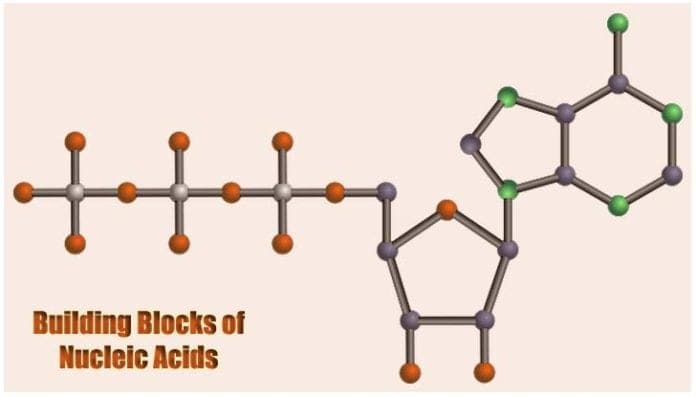
-
66 -
-
-
Construction Blocks of Nucleic Acids: The study of heredity (the pass of traits from parents to succeeding generations) primarily depends on the understanding of the biochemical properties of the genetic material namely DNA in eukaryotes and bacteria, and RNA in viruses.
It is life-or-death to notation that close to of the essential characteristics of the genetic material in the var. of nucleic acids arise from its construction blocks: the nucleotides.
Therefore, the knowledge about these small units bathroom service as critical points to the greater understanding of their theatrical role in biologic systems.
Downstairs, learn more about the building blocks of nucleic acids, their structures, functions, American Samoa well A their grandness.
Table of Table of contents
- What Is A Nucleotide?
- Structure of The Nucleotide
- Building Blocks of Nucleic Acids
- 1. Pentose Sugar
- 2. Phosphate Aggroup
- 3. Nitrogenous Base
- Types of Nucleotide Bases
- 1. Adenine (Purines)
- 2. Guanine (Purines)
- 3. Cytosine (Pyrimidines)
- 4. Thymine (Pyrimidines)
- 5. Uracil (Pyrimidines)
- Grandness of Nucleotides
- References
What Is A Nucleotide?
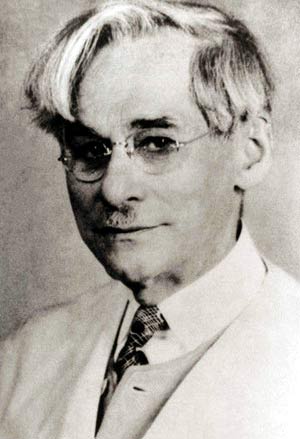
DNA and Ribonucleic acid are both made up of small building blocks called nucleotides. These units are covalently linked: 'tween the phosphate group of the twenty percent carbon of one nucleotide to the pentose kale attached to the third carbon of the intermediate nucleotide.
- Serial publication of these covalent linkages among nucleotide units form the polymer nucleic acids.
- DNA molecules are composed of deuce strands of these polymers and are coiled in a so-called "ambiguous helix". Ribonucleic acid molecules then again are one-person stranded and but suffer some regions where the Strand twists.
- American biochemist, Phoebus Levene first coined the term "nucleotide" in the 1900s, tall before James Watson and Francis Rick revealed the structure of the DNA.
![]()
Anatomical structure of The Nucleotide
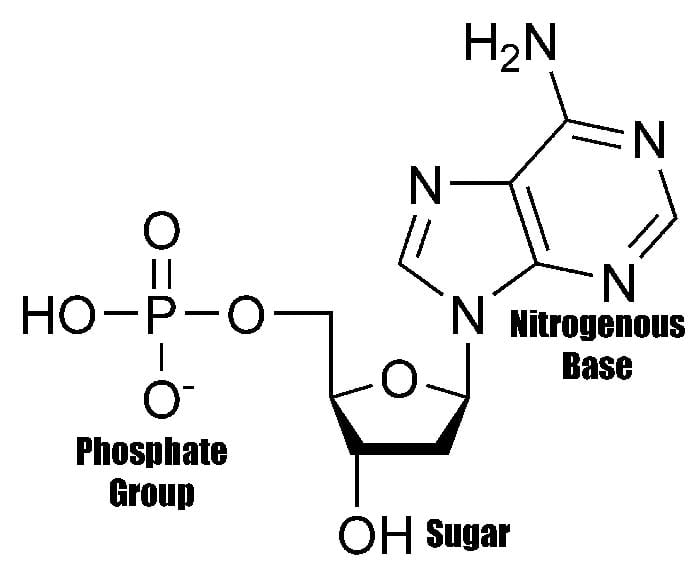
The structure of the nucleotide maximizes soldering potential equally it allows Lapplander building blocks to be engaged to one another through the formation of hydrogen bond between each nucleotide's nitrogenous base.
Such structure is also expeditious in allowing the creation of phosphodiester bonds between the pentose sugar of one nucleotide to the phosphate group of another. These connections, consequently, lead to generous the DNA's "two-fold-stranded" ladder-comparable cipher.
- While they appear to atomic number 4 almost identical, nucleotides and nucleosides can be differentiated finished their mien of phosphate groups in their construction; Nucleosides can constitute phosphorylated to produce nucleotides.
![]()
Building Blocks of Nucleic Acids
The social structure of nucleic acids (i.e., DNA) can be likened to a ravel that is made functioning of alternating stairs that are symbolizing its three significant parts: pentose sugar, the phosphate group, and the nitrogenous understructur.
1. Pentose Dinero
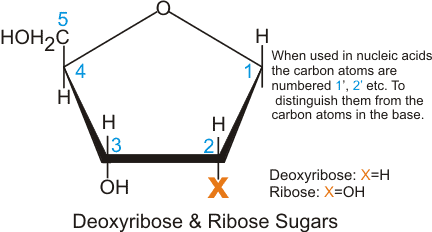
A pentose sugar is a basketball team-carbon copy sugar that serves as the polymer backbone of DNA and RNA. RNA has the ribose sugar spell DNA has the deoxyribose. The two dissent regarding the functional mathematical group attached to the second carbon position. An -OH group can be found in ribose spell deoxyribose has hydrogen instead.
- The difference in the number of oxygen atoms in their structures serves equally markers for enzymes to well mark them from from each one other.
- Also, this functional group difference makes the Ribonucleic acid relatively less stable than DNA. Because of the -OH grouping, RNA is readily hydrolyzed at alkalic pH.
![]()
2. Phosphate Group

On with the pentose sugar, the phosphate radical makes up the polymer backbone of DNA and RNA. The group is bespoken to the fifth carbon in place of the hydroxyl group group.
- The phosphate group determines the direction of the nucleic acids. The double-stranded nature of the Desoxyribonucleic acid can be attributed to the twisting of the polymer backbone. It is also negatively charged and can easy bond with water molecules.
![]()
3. Nitrogenous Base
Direct his observations, Phoebus Levene discovered that the transmitted material is made upwardly of quaternary little sub-units distributed in equal quantities.
- These were later found to be the nitrogenous bases adenine, G, C, T, and uracil. These Little Phoeb bases are further classified into two groups that is to say: pyrimidines and purines. Cytosine, thymine, and uracil are the pyrimidines while adenine and guanine are the purines.
- As its name suggest, A nitrogen-bearing base is a molecular social organisation that contains N and acts as a lowborn during a response.
![]()
Types of Nucleotide Bases
The bases are break u of the DNA and Ribonucleic acid that serve as the memory board of data and encodes for the phenotype, or the visible corporeal feature of an organism. The cardinal known nucleotide bases are described below.
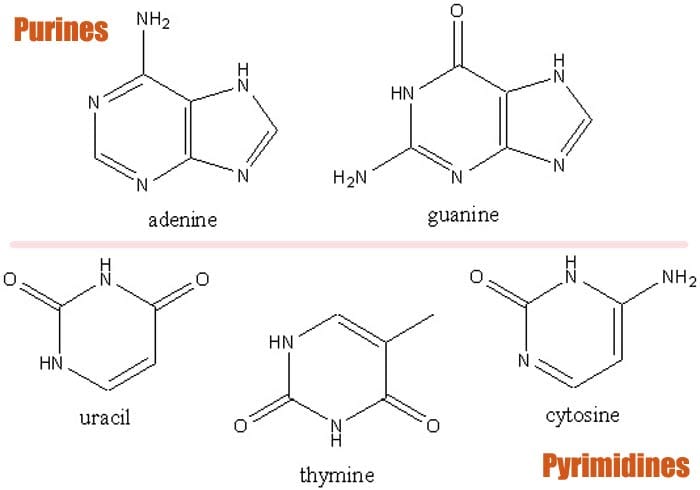
1. Adenine (Purines)
Atomic number 3 alluded to to begin with, A belongs to the purines which are self-contained of a nitrogen group with six members of atomic number 7 annulus attached to a ring with five nitrogen units. In DNA, A pairs with thymine whereas in RNA, it pairs with uracil.
Chemical recipe for Adenine: C5H5N5 .
- When amalgamated with ribose, adenine forms the nucleoside adenosine. On the other hand, when fused with deoxyribose, it forms deoxyadenosine.
- This adenosine is an essential component of adenosine triphosphate (ATP) which is a social unit of energy and is utilized during metabolism.
![]()
2. Guanine (Purines)
Also a purine molecule, guanine is composed of a fused system of pyrimidine and imidazole ring with double bond conjugates. This bicyclic molecule is planar due to being unsaturated.
Chemical formula for Guanine: C5H5N5O.
- As a nucleoside, guanine is called as guanosine.
- Guanine pairs with C.
![]()
3. Cytosine (Pyrimidines)
The next basic is the cytosine , a pyrimidine base that pairs with guanine. When combined with ribose, cytosine forms the nucleoside cytidine. This molecule canful then be farther phosphorylated to form phosphoric groups.
Chemical formula for C: C4H5N3O.
- Cytosine is precise essential in cancer biology since its deamination alone is the main effort in the formation of cancer like leukemia.
![]()
4. Thymine (Pyrimidines)
Derived from the hydrolysis of deoxyribonucleic acerb via catalytic reduction,thymine is a pyrimidine base that pairs with adenine in DNA. The bond is secured with a hydrogen bond that stabilizes the construction of the nucleic acid.
Chemical formula for Cytosine: C5H6N2O2 .
- In Ribonucleic acid, uracil replaces thymine at carbon five positions.
![]()
5. Uracil (Pyrimidines)
U is a pyrimidine that replaces thymine in RNA and therefore is the nonpareil that pairs with adenine. Through methylation, uracil can be converted into T.
Chemical formula for Cytosine: C4H4N2O2 .
- In the body, uracil is used to synthesize various enzymes which are needful for the exact functioning of cells.
![]()
Importance of Nucleotides

As building blocks of nucleic acids, nucleotides primarily aid in storing genetic selective information that will be later the basis for the manifestation of physical traits. Moreover, they also play roles in assorted biological and physiological processes. Equally molecules, they help in the transport of ATP and serve as biological catalysts in most reactions involving biomolecules.
![]()
Information technology is quite impressive to know that no living being in this world bears the same sequence of nucleotide bases. Because of so much inheritable diversity, organisms demo various phenotypes that help them survive.
What do you call back could have happened if the nucleotide never evolved just the likes of the way it is now?
![]()
Cite This Page
References
- – "MLA Common Era Course Manual: Molecular Biology Information Resources (Genetics Review: Nucleotide)". Accessed October 15, 2017. Link.
- – Nucleotides. Accessed October 15, 2017. Link.
- – "DNA Structure: The Discovery of Nucleic Sulphurous Social system". Accessed October 15, 2017. Connect.
- – "What are the Three Parts of a Nucleotide? | Albert.Io". Accessed October 15, 2017. Link.
- – "Pearson – The Biology Place". Accessed Oct 15, 2017. Link.
- – "phosphate backbone | Learn Science at Scitable". Accessed October 15, 2017. Tie in.
- – "A | C5H5N5 – PubChem". Accessed October 15, 2017. Associate.
- – "G | C5H5N5O – PubChem". Accessed October 15, 2017. Link.
- – "cytosine | C4H5N3O – PubChem". Accessed October 15, 2017. Link.
- – "thymine | C5H6N2O2 – PubChem". Accessed October 15, 2017. Nexus.
- – "U | C4H4N2O2 – PubChem". Accessed Oct 15, 2017. Link.
-
66 -
-
-
what are the building blocks of nucleic acids answers
Source: https://www.bioexplorer.net/building-blocks-of-nucleic-acids.html/
Posting Komentar